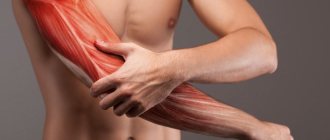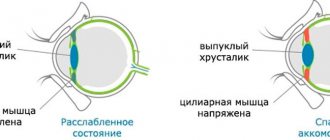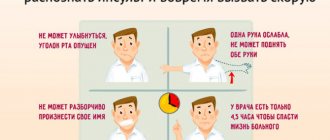Anticonvulsants appeared only 100 years ago. Over the past decades, scientists and manufacturers have been discovering new compounds and bringing new drugs to the market. How to make the right choice?
Cramps are involuntary muscle contractions. They can also occur in healthy people after overloading certain muscles, for example, in athletes, violinists, or during hypothermia in water. When falling asleep and during sleep, convulsive involuntary twitching is common. But various types of seizures can also be symptoms of epilepsy.
Causes of cerebral vasospasm
Angiospasm often occurs due to:
- overwork;
- nervous or physical stress;
- sedentary lifestyle (for example, prolonged sitting at the computer);
- stress and strong emotions, even positive ones;
- lack of sleep;
- lack of oxygen in the room;
- abuse of coffee and strong tea;
- vitamin deficiency;
- smoking;
- excessive alcohol consumption;
- hypothermia;
- atmospheric pressure fluctuations;
- age-related changes in the arteries.
Spasm of cerebral vessels can be a symptom of osteochondrosis of the cervical spine, arterial hypertension, cerebral aneurysm, tumor formation, vegetative-vascular dystonia, and thyroid diseases.
The risk group includes elderly people and people sensitive to weather changes, smokers, abuse alcohol, often drink strong tea/coffee, suffer from insomnia, hypertension, angina pectoris, diabetes mellitus or dyscirculatory encephalopathy, and have a family history of stroke or myocardial infarction .
Causes of drug-induced migraine
Medicinal migraine occurs when painkillers are abused, explains neurologist at the Headache and Autonomic Disorders Clinic, Academician Alexander Vein, Associate Professor of the Department of Nervous Diseases of Moscow State Medical University. THEM. Sechenova Nina Latysheva. Taking analgesics more than twice a week is addictive. The lifespan of the tablet is reduced. A person takes analgesics more often and becomes dependent.
Symptoms of headaches from the reverse effect of analgesics were described by a group of Russian scientists from the Moscow Federal State Budgetary Institution "Scientific Center of Neurology" and the Federal State Budgetary Educational Institution of Higher Education "Moscow State Medical and Dental University named after. A.I. Evdokimov." This pain is daily and varies in intensity. Pain increases with physical or emotional stress and discontinuation of medications.
It is not always easy to identify the causes of migraine, and sometimes it is impossible without a full examination.
Doctors at Germany's Essen University Hospital have described drug overuse as a global problem, with up to 4% of people overusing analgesics and other drugs to treat migraines and 1% of people in Europe, North America and Asia experiencing medication-induced headaches.
In Russia, patients also face headaches due to medications. German scientists from the University of Bochum, the Norwegian University of Science and Technology and the Russian Academy of Sciences examined 2,725 adults in 35 cities and nine villages in Russia. 213 (10.5%) respondents reported headaches 15 times a month or more often, 145 of them (68.1%) abused medications.
Scientists from the American Academy of Neurology have found out how long it takes to get used to drugs. The shortest period was for triptans - 1.7 years, for ergot - 2.7 years, for analgesics - 4.8 years. Patients who overused ergots and analgesics reported daily tension-type headaches (TTH), and patients who took triptans described migraine-like headaches or an increase in migraine attacks.
Be careful, some drugs are addictive.
Signs of cerebral vasospasm
The main symptom of the pathological process is headache of varying localization and intensity. It usually occurs in the temples and forehead, sometimes felt all over the head.
You may also experience:
- dizziness;
- pain in the eyes, ear, neck;
- noise in ears;
- “flies” before the eyes;
- darkening of the eyes;
- nausea;
- changes in blood pressure;
- feeling tired;
- numbness of lips;
- tingling in temples.
If a spasm is a precursor to a stroke or rupture of an aneurysm, disturbances in speech, sense of orientation in space and coordination of movements, and loss of consciousness are possible.
Popular questions and answers
We asked neurologists to answer questions related to headaches in the back of the head.
When can a headache in the back of your head be dangerous?
“Such symptoms,” says neurologist Olga Zincheva, “can include:
- concomitant increase in body temperature;
- weakness, awkwardness;
- numbness and tingling in the limbs or one limb;
- prolonged increase in pressure, difficult to reduce;
- severe headaches;
- headaches are accompanied by nausea and vomiting;
- double vision, impaired consciousness.
When to see a doctor for a headache in the back of the head?
“There are signs,” explains Olga Zincheva, “that require medical attention:
- you have a headache for the first time for no apparent reason;
- pain lasts several days;
- there are concomitant diseases.
“You need to go to the hospital immediately,” adds colleague Elena Gaivoronskaya, “if the headache occurs suddenly, it is very intense, there was no such pain before, or if the pain is accompanied by weakness in the limbs on one side of the body, a distortion of the face, speech disorder, or lack of coordination. If you have other alarming symptoms, you should consult a doctor as planned. You should also see a neurologist if you are taking too many pain medications or if your headaches are affecting your quality of life.
Treatment
If the problem is caused by external negative factors, they should be avoided if possible. If a spasm occurs against the background of any disease, therapy should be aimed at curing it.
At the same time, drugs are used to relieve spasms of cerebral vessels - No-Shpa, Halidor, Dibazol, Doverin, Papazol, Spazmol. They affect the muscular wall of blood vessels, reduce muscle tone, and expand the lumen of blood vessels.
You can also take painkillers for cerebral vasospasm - Analgin, Aspirin.
Antispasmodic analgesics are drugs of a combined composition that eliminate spasms and relieve pain. This group includes Pentalgin, Andipal, Baralgetas, Novigan, Spazgan, Spazmoblok.
To improve cerebral circulation, it is recommended to take nootropic drugs such as Actitropil, Gopantam, Idebenone, Nootropil, Recognan, Piracetam.
For the treatment of cerebrovascular disorders, medicines and dietary supplements based on ginkgo biloba leaf extract are widely used. This plant improves the rheological properties of blood and oxygen supply to the brain, normalizes microcirculation and metabolism in cells, reduces the permeability of vascular cells, and has antithrombotic and antihypoxic effects.
The patient is recommended physiotherapeutic procedures: oxygen therapy, kinesiotherapy, hydrotherapy, magnetic therapy, darsonvalization. Massages in the neck and back of the head help improve blood circulation.
Headache due to arterial hypertension
Arterial hypertension or hypertension (constantly high blood pressure) is one of the important etiological factors in the formation of headaches.
For a long time, this kind of cephalgia was classified as a vascular disease. Today, doctors are more inclined to attribute it to pathologies associated with disturbances of homeostasis (self-regulation, the body’s ability to constantly maintain a balance of internal state).
Arterial hypertension is a fairly common disease of the cardiovascular system, affecting approximately 20-30% of the entire adult population. In elderly and elderly people, the prevalence of the disease gradually increases and reaches 65%. Hereditary genetic factors play an important role in the occurrence of high blood pressure.
As a rule, hypertension is inherited or occurs as a result of intense psychological activity, frequent stress and the constant influence on the body of psycho-emotional factors that provoke disturbances in the brain regulation of the vasomotor system and/or hormonal mechanisms that control blood pressure. Headaches that appear against the background of hypertension require careful examination for their adequate treatment and parallel treatment of the underlying disease.
Mechanisms of headache
Today, doctors identify the following mechanisms that cause cephalalgia:
- pain associated with abnormalities of the vascular bed or pathologies of the cardiovascular system;
- pain caused by muscle strain or spasm;
- liquorodynamic disorders in the body;
- pain associated with neuralgic and/or mental disorders.
As statistics show, quite often the same patient experiences headaches from a combination of several of the above factors, and therapy only for arterial hypertension in the hope that the pain will go away on its own is often wrong.
Vascular factor
In turn, vascular headaches can be divided into:
- vasomotor (vegetative-vascular dystonia) with pronounced functional disorders of the tone of blood vessels, both arterial and venous;
- ischemic-hypoxic, in which organic changes in the walls of blood vessels are noted, such as in atherosclerosis or arterial hypertension.
Vasomotor manifestations of cephalgia, as a rule, are pulsating in nature, coinciding with the heart rhythm, radiating to the back of the head and temples, accompanied by tinnitus, dizziness, flashing spots in front of the eyes or diverging circles. At the same time, vasospasm itself (periodic narrowing of small arteries and capillaries) does not cause headaches in patients with mild to moderate systemic increases in blood pressure. It occurs in the event of a sharp increase in pressure, when the patient’s condition approaches a hypertensive crisis.
Ischemic headache is characterized by pressing, aching sensations, aching dull pain, accompanied by a feeling of “heaviness” in the head, distracted attention, lack of concentration, memory impairment, inability to concentrate, and blurred images. Such pain occurs against the background of progression of hypertensive discircular encephalopathy (brain damage) and is accompanied by cerebral circulation disorders, increased blood viscosity and changes in its rheological and aggregation properties.
The following contribute to ischemic cephalgia: vertebrobasilar vascular insufficiency, cervical osteochondrosis, muscle-tonic reactions of the neck and/or head. As a result of chronic compression of cerebral vessels, oxidative processes slow down (oxygen starvation), energy deficiency occurs and a number of pathological reactions develop, which provoke necrosis (death) of neurons.
Venous type headaches are caused by dysfunctions of the venous part of the circulatory system (its insufficiency or stagnation). May be accompanied by respiratory diseases and increased intrathoracic pressure.
As a rule, venous outflow of blood occurs in an upright position of the body, so such cephalgia occurs or intensifies after a long stay in a lying position (morning headaches), sitting with a low head, or when the chest is tense during a chronic cough.
Associated symptoms: “heaviness” of the head, dilation of the fundus veins, swelling of the face and eyelids, localization of pain in the occipital part of the head, at the projection site where the intracranial venous sinuses merge.
Muscle tension pain due to hypertension
This pathology is based on spasm and pain syndrome of muscle tissue, caused by two parallel or independent processes:
- Overstrain of the muscle fibers themselves, stagnation of blood in them, swelling, inflammation, then a change in chemical reactions (an increase in the concentration of potassium, which stimulates chemoreceptors). Chemoreceptors, in turn, convert chemical indicators into nerve impulses (excitation) and transmit them to the central nervous system.
- Emotional overstrain, which provokes spasm of muscle fibers and difficulty in passing neuromuscular signals through them.
Muscle spasms contribute to the accumulation of lactic acid in the fibers, the development of ischemia and hypoxia, which significantly increases headaches. Considering that people with arterial hypertension quite often have neurasthenic or depressive tendencies and feel a lack of psychological protection, muscle factors are added to the vascular factors.
In addition, the development of the disease is adversely affected by the presence of osteochondrosis disorders, postural curvatures, muscular-tonic anomalies, dysfunction of the temporal and mandibular joints, and inadequate vision correction. Chronic hypertonicity or spasm of the cervical and shoulder muscles causes reflex overstrain of the muscles of the head and scalp.
Such pain is characterized by a moderate-intensity feeling of a “hoop” or “hat” placed on the head, localized in the occipital-parietal or frontal lobes. The pain syndrome weakens with adequate physical activity, acupressure, muscle relaxation or massage and intensifies with emotional overstimulation. It is worth noting that quite often, when tension headaches are eliminated in patients with arterial hypertension, blood pressure normalizes.
Liquorodynamic pain
Liquorodynamic cephalalgia appears against the background of an increase or decrease in the production (production) of cerebrospinal fluid, as well as disturbances in its outflow due to any pathological processes. In patients suffering from hypertension, such headaches are associated with cerebral edema after a hypertensive crisis or exacerbation of encephalopathy. Quite often they are combined with venous stagnation of blood and venous pain.
Intracranial hypertension is characterized by bursting pain, accompanied by nausea, vomiting, dizziness, and with severe cerebral edema - confusion, disturbances in coherent speech, hearing and vision. The pain eases when the person takes an upright position or sleeps on a high pillow. Additional signs of pathology are: pain when pressing on the eyeballs, stagnation of venous blood in the fundus, swelling of the area and the optic nerve itself, hydrocephalus.
Such headaches are characterized by dull, low-intensity, but chronically generalized sensations, and when blood pressure increases, they become pulsating.
Neuralgic factors
Neurological headaches are the most specific of all of the above and belong to the category of prosopalgia (headaches of the facial area without a specific genesis). The nature of the manifestations is characterized by short bursts of shooting pain that occur one after another and the presence of trigger zones that give rise to paroxysm.
For example, with trigeminal facial neuralgia, an increase in blood pressure during a hypertensive crisis can cause neurological paroxysm. At the same time, the development of hypertensive discircular encephalopathy can cause neuralgia, ischemia or compression of the trigeminal nerve.
The psychogenic mechanisms of the occurrence of cephalgia are associated with anomalies of nociception that occur after hysterical or depressive syndromes, and neurosis-like conditions, in turn, are quite often present in arterial hypertension. The pain sensations vary for each patient and have their own specifics, but in any case they interfere with normal life and work.
Relationship between cerebral blood flow, hypertension and cephalalgia
It is worth noting again that chronically high blood pressure in most cases is not the direct cause of headaches. On the contrary, pain syndrome occurs after a sharp drop in blood pressure, when it is knocked down during a crisis.
Cerebral blood flow is also quite autonomous and practically does not depend on pressure changes; it begins to change slowly and passively only at critical levels (minimum - 50-60 mm Hg, maximum - more than 200). At the same time, normal functioning and functioning of the brain is possible only with a complete blood supply. Circulatory disorders cause cerebral ischemia and dysfunction.
The protective reaction of the brain to long-term hypertension is the development of compensatory hypertrophy of the muscular linings of blood vessels, which are able to restrain blood pressure and normalize cerebral circulation. This allows you to move the upper limit even higher and, as statistics show, hypertensive patients with a working pressure of 200 mm Hg. Art. practically do not complain of headaches.
Diagnostic algorithms for excluding secondary headaches in hypertension
In parallel with constantly elevated blood pressure, other diseases can develop, the manifestation of which is cephalalgia. To identify and exclude such situations, additional clinical studies are carried out:
- Anamnesis collection.
- Examination of the head (excluding manifestations of head injuries, cervical spine injuries, muscle spasms and inflammation, compactions in the tendons, changes in blood flow in the temporal and vertebral arteries).
- Examination of the neural network of the head and skull, exclusion of neuralgia and neuritis.
- Diagnosis of the organs of vision, fundus of the eye, exclusion of acute glaucoma.
- Examination of the oral cavity (exclusion of dental pathologies), palatine vaults, rhinitis and sinusitis cavities.
- Diagnosis of the functioning of the facial joints (temporal, mandibular, their range of motion, symmetry), checking the bite.
- Exclusion of osteochondrosis, pathologies of muscle tissue (spasm, congestion, inflammation), developmental anomalies of the cervical spine.
- Checking for postural disorders and asymmetries in the development of skeletal muscles, which can also cause headaches.
- Diagnosis of possible meningitis, subarachnoid hemorrhages, vascular blockages.
- Exclusion of tumor formations and metastases.
- Examination of the lymphatic system and nodes, thyroid gland, ears, lungs, heart and other internal organs.
- Rule out increased intracranial pressure.
Pain syndromes combined with arterial hypertension, which should alert patients:
- the occurrence of chronic pain in older age (over 50 years);
- a significant increase in habitual pain or a significant difference in their manifestations;
- the occurrence of night headaches;
- increased pain during physical effort or stress, sudden movements;
- a combination of pain with neurological abnormalities (confusion, consciousness, impaired coordination, weakened memory, dysfunction of the organs of vision, smell and hearing);
- the occurrence of nausea, vomiting, dizziness, especially in the morning;
- chronically elevated body temperature, fever, weight loss, prolonged cough or rhinitis.
Author: K.M.N., Academician of the Russian Academy of Medical Sciences M.A. Bobyr
Prevention
Preventive measures are aimed at maintaining the normal functioning of the circulatory system and strengthening blood vessels. These include:
- normalization of work and rest schedules;
- good sleep;
- moderate exercise;
- hardening;
- to give up smoking;
- reasonable alcohol consumption;
- adequate drinking regime;
- avoiding hypothermia;
- proper nutrition.
Doctors recommend eating more vegetables, fruits and herbs, and giving preference to fish and lean meats. Limit the consumption of butter, coffee, black tea, cocoa, sugar, chocolate, smoked meats, lamb and pork, mayonnaise and sauces, fried foods.
Popular questions about cerebral vasospasm
How to understand the cause of a headache?
First of all, it’s worth analyzing the situation - what could be causing the problem? Perhaps a headache occurs when the weather changes, after excessive physical exertion, hypothermia, stress, or frequent lack of sleep. If there is no explainable reason, you should definitely seek help from a doctor.
What drugs can be taken without a doctor's prescription?
Most non-narcotic analgesics and antispasmodics are sold without a prescription.
The most effective drugs?
The best tablets for cerebral vasospasm are combined drugs that have analgesic and antispasmodic effects, for example, Bralangin, Pentalgin and Spazmalgon. Antispasmodics that reduce vascular tone, for example, Papaverine and Drotaverine, are also effective.
Treating headaches with NSAIDs
For tension headaches and migraines, neurologists prefer nonsteroidal anti-inflammatory drugs (NSAIDs). Helps with headaches:
- acetylsalicylic acid (aspirin) – the maximum single dose is 2 tablets, but not more than six tablets 3-4 times a day;
- naproxen – you can take 2 tablets at a time, but no more than four tablets 2 times a day.
- diclofenac - take one tablet 3 times a day;
- indomethacin - can be taken one tablet 3 times a day or used in the form of rectal suppositories;
- Ketonal, ketanov, ketorol should be taken orally no more than 2 tablets at a time, 3-4 times a day.
According to reviews, Nurofen and Nimesil help well with headaches. Doctors recommend taking all drugs in this group after meals with plenty of water. The effect develops 0.5-2 hours after taking the drug. The duration of the analgesic effect is 4-6 hours. The tablets can be taken independently for no more than 4 days. Dexalgin acts quickly and effectively for headaches.









